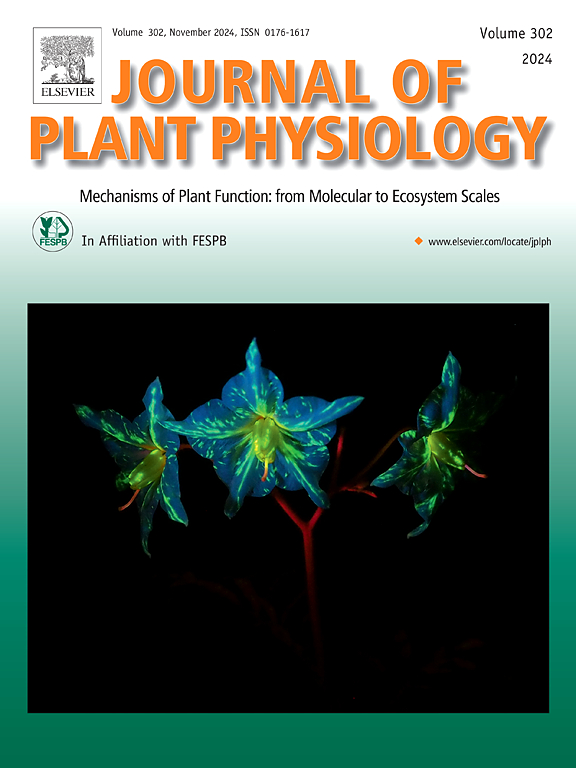氮源和有效性与日本莲线粒体呼吸途径和共生功能的关系
IF 4.1
3区 生物学
Q1 PLANT SCIENCES
引用次数: 0
摘要
豆科植物与固氮细菌形成共生关系,在代谢方面研究得很好,但在呼吸方面研究得较少。共生固氮需要高呼吸ATP和碳骨架,将氮同化和NADH和ATP依赖过程与线粒体呼吸联系起来。植物线粒体电子传递链包含两种末端氧化酶,它们对18O进行不同的分馏法,提供了体内呼吸能量效率的估计。植物呼吸参数对N2固定的调节尚不清楚。为了研究这两种代谢过程的相互调节作用,我们测试了不同植物氮状态和来源对荷花呼吸参数和营养的影响。施用5mM和25mM两个水平的KNO3,并施用固氮共生菌洛蒂中根瘤菌(Mesorhizobium loti)。此外,我们通过生长显示自发结节形成(snf) (snf)的植物来表征含有非固定结节的根。我们利用同位素比质谱法评估了叶片和根系呼吸过程中13C和15N的天然丰度,以及18O的辨别。采用超高效液相色谱法和电感耦合等离子体光谱法测定NADH和营养成分含量。我们观察到,细胞色素c氧化酶活性在固氮能力强的根瘤根中高于硝酸盐有效利用率高的根瘤根,并且氮状态与呼吸参数密切相关。这些发现强调了细胞色素c氧化酶在满足共生固氮对碳和能量的需求方面的作用。本文章由计算机程序翻译,如有差异,请以英文原文为准。
Nitrogen Source and Availability Associate to Mitochondrial Respiratory Pathways and Symbiotic Function in Lotus japonicus
Legumes form symbioses with nitrogen-fixing bacteria, well studied metabolically but less so in terms of respiration. Symbiotic nitrogen fixation demands high respiratory ATP and carbon skeletons, linking nitrogen assimilation and both NADH- and ATP-dependent process to mitochondrial respiration. The plant mitochondrial electron transport chain contains two terminal oxidases that differentially fractionate against 18O, providing estimations in vivo of the energy efficiency of respiration. The regulation of N2 fixation by plant respiratory parameters remains unknown. To investigate the regulatory interactions of these two metabolic processes, we tested the effect of different plant N status and sources on respiratory parameters and nutrition in Lotus japonicus. Plants were grown with two levels of KNO3 fertilization (5 mM and 25mM) and with the N2 fixing symbiotic bacteria Mesorhizobium loti, which induced the formation of root nodules (NP). Additionally, we characterized roots containing non-fixing nodules by growing plants that display spontaneous nodule formation (snf) (SNF). We evaluated the natural abundances of 13C and 15N, and 18O discrimination during respiration in leaves and roots using isotope-ratio mass spectrometry. NADH and nutrient content were measured using ultra-performance liquid chromatography and inductively coupled plasma spectrometry. We observed that cytochrome c oxidase activity was higher in nodulated roots capable of nitrogen fixation than in plants fertilized with high availability of nitrate, and that nitrogen status strongly associates to respiratory parameters. These findings highlight the role of cytochrome c oxidase in meeting the carbon and energy demands of symbiotic nitrogen fixation.
求助全文
通过发布文献求助,成功后即可免费获取论文全文。
去求助
来源期刊

Journal of plant physiology
生物-植物科学
CiteScore
7.20
自引率
4.70%
发文量
196
审稿时长
32 days
期刊介绍:
The Journal of Plant Physiology is a broad-spectrum journal that welcomes high-quality submissions in all major areas of plant physiology, including plant biochemistry, functional biotechnology, computational and synthetic plant biology, growth and development, photosynthesis and respiration, transport and translocation, plant-microbe interactions, biotic and abiotic stress. Studies are welcome at all levels of integration ranging from molecules and cells to organisms and their environments and are expected to use state-of-the-art methodologies. Pure gene expression studies are not within the focus of our journal. To be considered for publication, papers must significantly contribute to the mechanistic understanding of physiological processes, and not be merely descriptive, or confirmatory of previous results. We encourage the submission of papers that explore the physiology of non-model as well as accepted model species and those that bridge basic and applied research. For instance, studies on agricultural plants that show new physiological mechanisms to improve agricultural efficiency are welcome. Studies performed under uncontrolled situations (e.g. field conditions) not providing mechanistic insight will not be considered for publication.
The Journal of Plant Physiology publishes several types of articles: Original Research Articles, Reviews, Perspectives Articles, and Short Communications. Reviews and Perspectives will be solicited by the Editors; unsolicited reviews are also welcome but only from authors with a strong track record in the field of the review. Original research papers comprise the majority of published contributions.
 求助内容:
求助内容: 应助结果提醒方式:
应助结果提醒方式:


